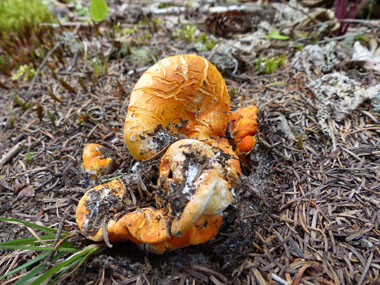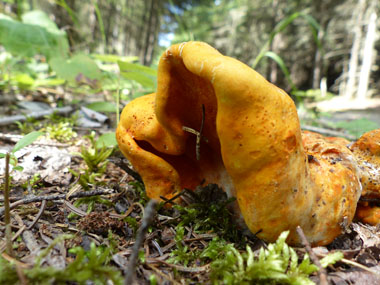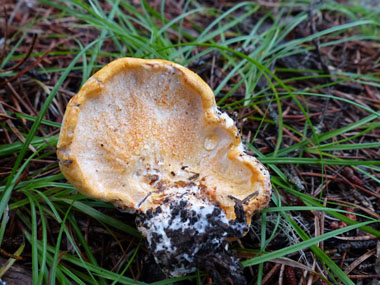






Do not eat any fungi that has not been properly identified by a qualified professional, some are DEADLY when ingested. All edible wild fungi MUST be cooked.
The overall look is that of a capped mushroom (which contorts with age) covered with a finely bumpy, vivid orange to orange-red layer. The gills of the host mushroom can be entirely obscured by this parasite. It will still produce spores, but only those of Hypomyces Lactifluorum. These emanate from countless reddish-orange perithecial mounds (pimples) which dot the surface at maturity.
Type
Distinguishing Features
Lobster mushroom ‘fungus’ creates the bright orange covering over a Russula or Lactarius mushroom. The surface is rather hard, and dotted with tiny pimples. These orange mushroom pimples deform the mushroom’s gills and prevent the host mushroom from producing spores. The inside is white. Over a period of a couple of days, the fungus transforms the shape of the host mushroom, twisting it into odd shapes.
Height
The size of the lobster mushroom varies, depending on the size of the host mushroom. On average they are about15 - 20cm (6 - 8”) tall.
Habitat
Lobsters are found throughout North America and they tend to like old-growth forests best.
Spore Print
White.
Season
Late July to October.
Gills
The gills are transformed to blunt, chanterelle-like ridges.
Edibility
Russula brevipes and Lactarius piperatus are the host mushrooms in which Hypomyces lactifluorum is created rendering this edible. Be sure you have properly identified this mushroom before picking. Be sure the inside “meat” is white and always cook thoroughly before consuming.
Recipes
To support our efforts please browse our store (books with medicinal info, etc.).
Winter Survival Food Handbook

PDF Plant Magazines
Types of Wild Food
Geographic Zones Seasons
Disclaimer
EdibleWildFood.com is informational in nature. While we strive to be 100% accurate, it is solely up to the reader to ensure proper plant identification. Some wild plants are poisonous or can have serious adverse health effects.
We are not health professionals, medical doctors, nor are we nutritionists. It is up to the reader to verify nutritional information and health benefits with qualified professionals for all edible plants listed in this web site. Please click here for more information.
Why Edible Wild Food?
- Food costs are rising
- Free, wild food is readily abundant
- Wild food adds nutrition to your diet
- Wild food can help treat various medical conditions





